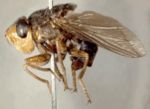Dermatobia hominis
| This article is still under construction. |
| Dermatobia hominis | |
|---|---|
| Class | Secernentea |
| Order | Diptera |
| Family | Oestridae |
| Genus | Dermatobia |
| Species | D. hominis |
| Also known as: | Human bot fly
|
Hosts
Humans, many birds and most domestic and wild animals.
Identification
The mature larvae may grow up to 25mm in length. D. hominis are similar to Calliphora in appearance, and are of the family Oestridae. They have a blue-black abdomen, and have yellow-orange head and legs.
Larvae are distinctive as they taper towards the posterior end
Life cycle
The adults do not feed, and draw food from the larvae, which accumulate stores throughout their developmental stage. The female then catches an insect, most commonly the mosquito, and lays a batch of eggs on it.
The insect lands on a host, and the L1 larvae then hatch on the host, and quickly penetrate the skin. The larvae undergo a transformation to L2, and then subsequently to L3. The larvae fully mature, and then move to the ground to pupate. They then emerge later as adults.
It is a 4 month life cycle.
References
Taylor, M.A, Coop, R.L., Wall,R.L. (2007) Veterinary Parasitology Blackwell Publishing

